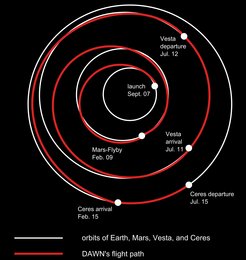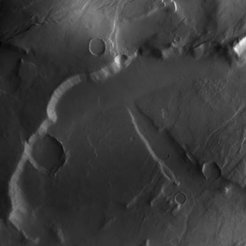
Mission
Dawn - a journey to the beginning of our solar system
Dawn is a NASA mission managed by the Jet Propulsion Laboratory (JPL), a division of the California Institute of Technology in Pasadena, for NASA's Science Mission Directorate, Washington. The University of California, Los Angeles, is responsible for overall Dawn mission science.
The space probe’s two destinations are the protoplanet Vesta and the dwarf planet Ceres that circle the Sun within the so-called aseroid belt between the orbits of Mars and Jupiter. The Max Planck Institute for Solar System Research has contributed the mission’s on borard camera system. The two identical cameras were developed and built under the leadership of the Max Planck Institute for Solar System Research with significant contributions by the Institute for Planetary Research of the German Aerospace Center (DLR) and in coordination with the Institute of Computer and Communication Network Engineering of the Technical University Braunschweig.
But the Dawn mission, which was launched in September 2007, is far more than a journey to two distant bodies. It is a journey back in time to the beginnings of our solar system more than 4,5 billion years ago. Vesta and Ceres are among the largest survivors from this early phase of planet formation. All other larger bodies either merged to form planets or broke apart due to heavy collisions. The internal structure and the surfaces of Vesta and Ceres, however, have remained mostly unchanged. They therefore offer scientists the opportunity to take look back into time.
Dawn's long journey

On September 27, 2007, the space probe started on its long journey.
It arrived at its first scientific destination, the protoplanet Vesta, on 16. July 2011. In the following 13 months, Dawn entered into orbits that were closer and closer to Vesta’s surface. Between December 2011 and May 2012, only 210 kilometers separated both.
Dawn will reach ceres’ orbit in March 2015 and during the following months, it will approach Ceres’ surface up to a distance of approximately 700 kilometers.
Mars Flyby

In order to save fuel on its way to the asteroid belt, Dawn flew closely by Mars in February 2009. Such a maneuver allows the spacecraft to pick up momentum. In addition, the swing-by was a welcome opportunity to test the scientific instruments on a relatively close target. The cameras onboard obtained detailed images of Mars’ surface during fly-by.
Dawn mission schedule
September 27, 2007: launch
February 18, 2009: Mars Flyby
July 16, 2011: arrival at Vesta
August 1, 2011: first pictures from Vesta with a high resolution
September 5, 2012: departure from Vesta
March 2015: arrival at Ceres
July 2015: departure from Ceres
Scientific instruments on board
Dawn carries three scientific instruments on board: The Framing Cameras (FC), the detector for gamma-radiation and neutrons GRaND, and the spectrograph VIR.
The Framing Cameras were developed and built under the lead of the Max Planck Institute for Solar System Research (Germany) in cooperation with the Institute for Planetary Research of the German Aerospace Center (DLR) and the Institute for Computer and Network Engineering of the Technische Universität Braunschweig. The camera is operated by the Max Planck Institute for Solar System Research during the mission.
GRaND was built by the Los Alamos National Laboratory in New Mexico (USA) and is operated by the Planetary Science Institute, Tucscon, Arizona. Its objective is to detect elements like oxygen, magnesium, aluminum , silicon, calcium, titanium and iron.
The VIR spectrograph studies the visible and infrared solar radiation that the asteroids reflect into space. This data contains information about the mineralogical composition. VIR was provided by the Italian Space Agency (ASI) and developed and built by Galileo Avionica.
In addition, Vesta’s gravity field will be determined using high-accuracy navigation to reveal the structure of Vesta’s interior.
The Dawn mission is led by the NASA’s Jet Propulsion Laboratory (JPL). JPL is a department of the California Institute of Technology, Pasadena. The University of California, Los Angeles, is responsible for the scientific part of the mission.

